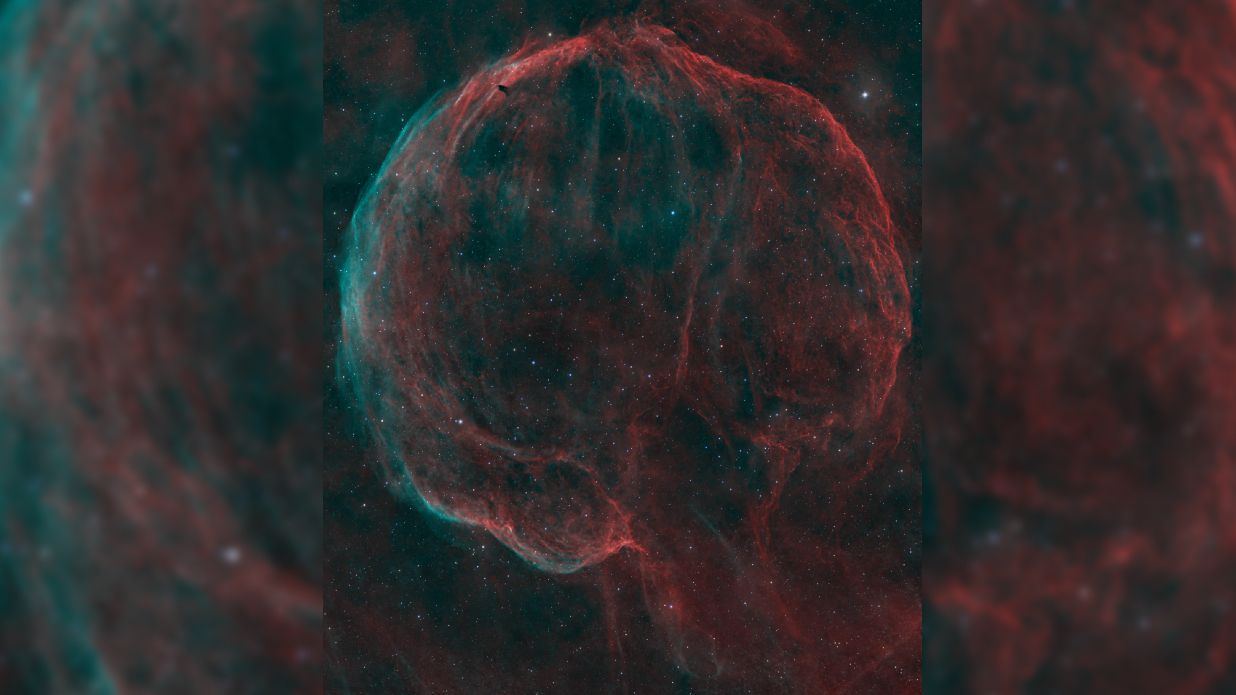Science
Astrophotographer Reveals Stunning Image of Medulla Nebula

Astrophotographer David Joyce from Lexington, Kentucky, has unveiled a breathtaking image of the Medulla Nebula, also known as the Garlic Nebula. This captivating deep-space photograph showcases a supernova remnant, a result of a massive star’s explosion that occurred approximately 10,000 years ago. Joyce’s work highlights the beauty and complexity of this cosmic structure, located about 9,132 light-years from Earth in the constellation Cassiopeia.
The nebula, identified as CTB 1, resembles both a bulbous plant and a human brain, which accounts for its dual nomenclature. The photograph captures the expanding shell of the supernova remnant, which has been observable in various wavelengths, including radio, X-ray, and visible light. The explosion propelled a cloud of stellar material outward, interacting with interstellar gas and creating the spectacular visual phenomenon Joyce managed to photograph.
Joyce shared insights into the challenges he faced while capturing this image. “This was relatively difficult to capture from my light-polluted suburban backyard under Bortle 7 skies,” he explained in an email to Space.com. He dedicated over 50 hours of exposure time to bring out the nebula’s intricate details, emphasizing the faintness of the object.
Technical Details of the Capture
To achieve this remarkable photograph, Joyce utilized an 8-inch Schmidt-Cassegrain telescope paired with a ZWO astronomy camera, along with several peripherals and filters. His efforts spanned seven clear nights in September 2023. After capturing the light data, he employed astronomy software for post-processing, resulting in a stunning nebula landscape.
Joyce expressed his long-standing interest in imaging CTB 1, stating, “I have wanted to image this supernova remnant since I started with astrophotography in 2020, but was never able to get it framed up just right with the equipment I had.” His recent purchase of a larger sensor camera allowed him to finally capture the nebula as he had envisioned.
The Garlic Nebula is not only an aesthetic marvel but also a site of significant scientific interest. The supernova explosion that formed CTB 1 also led to the birth of a superdense pulsar, discovered in 2009 by the NASA Fermi Gamma-ray Space Telescope. This pulsar is traveling at an astounding 2.5 million miles per hour (4 million km/h) from its origin.
Joyce’s achievement exemplifies the dedication and skill of amateur astronomers in capturing the wonders of the universe. For those interested in astrophotography, resources are available on the best cameras and lenses, along with guides on telescopes and binocular deals for the coming year.
As Joyce continues to share his journey in astrophotography, he invites others to contribute their deep space images. Interested photographers can submit their work to Space.com to showcase their passion for the cosmos.
-

 Politics1 week ago
Politics1 week agoDallin H. Oaks Assumes Leadership of Latter-day Saints Church
-

 Sports1 week ago
Sports1 week agoSteve Kerr Supports Jonathan Kuminga After Ejection in Preseason Game
-

 Lifestyle1 week ago
Lifestyle1 week agoDua Lipa Celebrates Passing GCSE Spanish During World Tour
-

 Business1 week ago
Business1 week agoTyler Technologies Set to Reveal Q3 2025 Earnings on October 22
-

 Entertainment1 week ago
Entertainment1 week agoZoe Saldana Advocates for James Cameron’s Avatar Documentary
-

 World1 week ago
World1 week agoD’Angelo, Iconic R&B Singer, Dies at 51 After Cancer Battle
-

 Health1 week ago
Health1 week agoRichard Feldman Urges Ban on Menthol in Cigarettes and Vapes
-

 Health1 week ago
Health1 week agoCommunity Unites for Seventh Annual Mental Health Awareness Walk
-

 Science1 week ago
Science1 week agoChicago’s Viral ‘Rat Hole’ Likely Created by Squirrel, Study Reveals
-

 Lifestyle1 week ago
Lifestyle1 week agoKelsea Ballerini Launches ‘Burn the Baggage’ Candle with Ranger Station
-

 Business1 week ago
Business1 week agoMega Millions Jackpot Reaches $600 Million Ahead of Drawings
-

 Business1 week ago
Business1 week agoMLB Qualifying Offer Jumps to $22.02 Million for 2024







